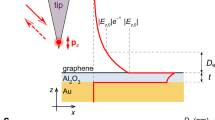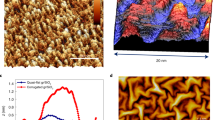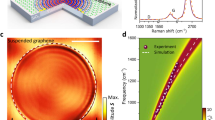Abstract
Surface plasmons are collective oscillations of electrons in metals or semiconductors that enable confinement and control of electromagnetic energy at subwavelength scales1,2,3,4,5. Rapid progress in plasmonics has largely relied on advances in device nano-fabrication5,6,7, whereas less attention has been paid to the tunable properties of plasmonic media. One such medium—graphene—is amenable to convenient tuning of its electronic and optical properties by varying the applied voltage8,9,10,11. Here, using infrared nano-imaging, we show that common graphene/SiO2/Si back-gated structures support propagating surface plasmons. The wavelength of graphene plasmons is of the order of 200 nanometres at technologically relevant infrared frequencies, and they can propagate several times this distance. We have succeeded in altering both the amplitude and the wavelength of these plasmons by varying the gate voltage. Using plasmon interferometry, we investigated losses in graphene by exploring real-space profiles of plasmon standing waves formed between the tip of our nano-probe and the edges of the samples. Plasmon dissipation quantified through this analysis is linked to the exotic electrodynamics of graphene10. Standard plasmonic figures of merit of our tunable graphene devices surpass those of common metal-based structures.
This is a preview of subscription content, access via your institution
Access options
Subscribe to this journal
Receive 51 print issues and online access
$199.00 per year
only $3.90 per issue
Buy this article
- Purchase on Springer Link
- Instant access to full article PDF
Prices may be subject to local taxes which are calculated during checkout



Similar content being viewed by others
References
Atwater, H. A. The promise of plasmonics. Sci. Am. 296, 56–62 (2007)
West, P. R. et al. Searching for better plasmonic materials. Laser Photon. Rev. 4, 795–808 (2010)
Stockman, M. I. Nanoplasmonics: the physics behind the applications. Phys. Today 64, 39–44 (2011)
Maier, S. A. Plasmonics: Fundamentals and Applications Ch. 4 (Springer, 2007)
Schuller, J. A. et al. Plasmonics for extreme light concentration and manipulation. Nature Mater. 9, 193–204 (2010)
Nagpal, P., Lindquist, N. C., Oh, S.-H. & Norris, D. J. Ultrasmooth patterned metals for plasmonics and metamaterials. Science 325, 594–597 (2009)
Lal, S., Link, S. & Halas, N. J. Nano-optics from sensing to waveguiding. Nature Photon. 1, 641–648 (2007)
Castro Neto, A. H., Guinea, F., Peres, N. M. R., Novoselov, K. S. & Geim, A. K. The electronic properties of graphene. Rev. Mod. Phys. 81, 109–162 (2009)
Wang, F. et al. Gate-variable optical transitions in graphene. Science 320, 206–209 (2008)
Li, Z. Q. et al. Dirac charge dynamics in graphene by infrared spectroscopy. Nature Phys. 4, 532–535 (2008)
Vakil, A. & Engheta, N. Transformation optics using graphene. Science 332, 1291–1294 (2011)
Jablan, M., Buljan, H. & Soljacic, M. Plasmonics in graphene at infrared frequencies. Phys. Rev. B 80, 245435 (2009)
Fei, Z. et al. Infrared nanoscopy of Dirac plasmons at the graphene-SiO2 interface. Nano Lett. 11, 4701–4705 (2011)
Ju, L. et al. Graphene plasmonics for tunable terahertz metamaterials. Nature Nanotechnol. 6, 630–634 (2011)
Huber, A., Ocelic, N., Kazantsev, D. & Hillenbrand, R. Near-field imaging of mid-infrared surface phonon polariton propagation. Appl. Phys. Lett. 87, 081103 (2005)
Dallapiccola, R., Dubois, C., Gopinath, A., Stellacci, F. & Dal Negro, L. Near-field excitation and near-field detection of propagating surface plasmon polaritons on Au waveguide structures. Appl. Phys. Lett. 94, 243118 (2009)
Casiraghi, C. et al. Raman spectroscopy of graphene edges. Nano Lett. 9, 1433–1441 (2009)
Caridad, J. M. et al. Effects of particle contamination and substrate interaction on the Raman response of unintentionally doped graphene. J. Appl. Phys. 108, 084321 (2010)
Hwang, E. H. & Das Sarma, S. Dielectric function, screening, and plasmons in two-dimensional graphene. Phys. Rev. B 75, 205418 (2007)
Ando, T., Zheng, Y. & Suzuura, H. Dynamical conductivity and zero-mode anomaly in honeycomb lattices. J. Phys. Soc. Jpn 71, 1318–1324 (2002)
Peres, N. M. R., Guinea, F. & Castro Neto, A. H. Electronic properties of disordered two-dimensional carbon. Phys. Rev. B 73, 125411 (2006)
Gusynin, V. P. & Sharapov, S. G. Transport of Dirac quasiparticles in graphene: Hall and optical conductivities. Phys. Rev. B 73, 245411 (2006)
Grushin, A. G., Valenzuela, B. & Vozmediano, M. A. H. Effect of Coulomb interactions on the optical properties of doped graphene. Phys. Rev. B 80, 155417 (2009)
Peres, N. M. R., Ribeiro, R. M. & Castro-Neto, A. H. Excitonic effects in the optical conductivity of gated graphene. Phys. Rev. Lett. 105, 055501 (2010)
Hwang, J., Leblanc, J. P. F. & Carbotte, J. P. Optical self-energy in graphene due to correlations. J. Phys. Condens. Matter 24, 245601 (2012)
Rana, F. Graphene terahertz plasmon oscillators. IEEE Trans. Nanotechol. 7, 91–99 (2008)
Chen, J. et al. Optical nano-imaging of gate-tunable graphene plasmons. Nature http://dx.doi.org/10.1038/nature11254 (this issue).
Novotny, L. & Hecht, B. Principles of Nano-Optics (Cambridge Univ. Press, 2006)
Das, A. et al. Monitoring dopants by Raman scattering in an electrochemically top-gated graphene transistor. Nature Nanotechnol. 3, 210–215 (2008)
Rodin, A. S. Electronic Properties of Low-Dimensional Systems. PhD thesis, UCSD (2012)
Acknowledgements
We acknowledge support from AFOSR, ONR and DARPA. The analysis of plasmonic losses and many-body effects was supported by DOE-BES grant DE-FG02-00ER45799. W.B., Z.Z. and C.N.L. were supported by NSF DMR/1106358, ONR N00014-09-1-0724, ONR/DMEA H94003-10-2-1003 and FENA Focus Center. G.D. and M.T. were supported by NASA. M.M.F. was supported by UCOP and NSF PHY11-25915. A.H.C.N. acknowledges NRF-CRP grant R-144-000-295-281. L.M.Z was supported by DOE grant no. DE-FG02-08ER46512. M.W. thanks the Alexander von Humboldt Foundation for financial support. F.K. was supported by Deutsche Forschungsgemeinschaft through the Cluster of Excellence Munich Centre for Advanced Photonics.
Author information
Authors and Affiliations
Contributions
All authors were involved in designing the research, performing the research, and writing the paper.
Corresponding author
Ethics declarations
Competing interests
F.K. is co-founder of Neaspec, producer of the scattering-type scanning near-field optical microscope apparatus used in this study. The other authors declare no competing financial interests.
Supplementary information
Supplementary information
This file contains Supplementary Text and Data 1-5, Supplementary Figure 1 and additional references. (PDF 182 kb)
Rights and permissions
About this article
Cite this article
Fei, Z., Rodin, A., Andreev, G. et al. Gate-tuning of graphene plasmons revealed by infrared nano-imaging. Nature 487, 82–85 (2012). https://doi.org/10.1038/nature11253
Received:
Accepted:
Published:
Issue Date:
DOI: https://doi.org/10.1038/nature11253
This article is cited by
-
Synthesized complex-frequency excitation for ultrasensitive molecular sensing
eLight (2024)
-
Synergistic-potential engineering enables high-efficiency graphene photodetectors for near- to mid-infrared light
Nature Communications (2024)
-
Tunable Cherenkov Terahertz Graphene Surface Plasmon Generation in Graphene Sheet by a Moving Relativistic Electron Beam
Plasmonics (2024)
-
Extreme light confinement and control in low-symmetry phonon-polaritonic crystals
Nature Reviews Materials (2023)
-
Visible to mid-infrared giant in-plane optical anisotropy in ternary van der Waals crystals
Nature Communications (2023)
Comments
By submitting a comment you agree to abide by our Terms and Community Guidelines. If you find something abusive or that does not comply with our terms or guidelines please flag it as inappropriate.



